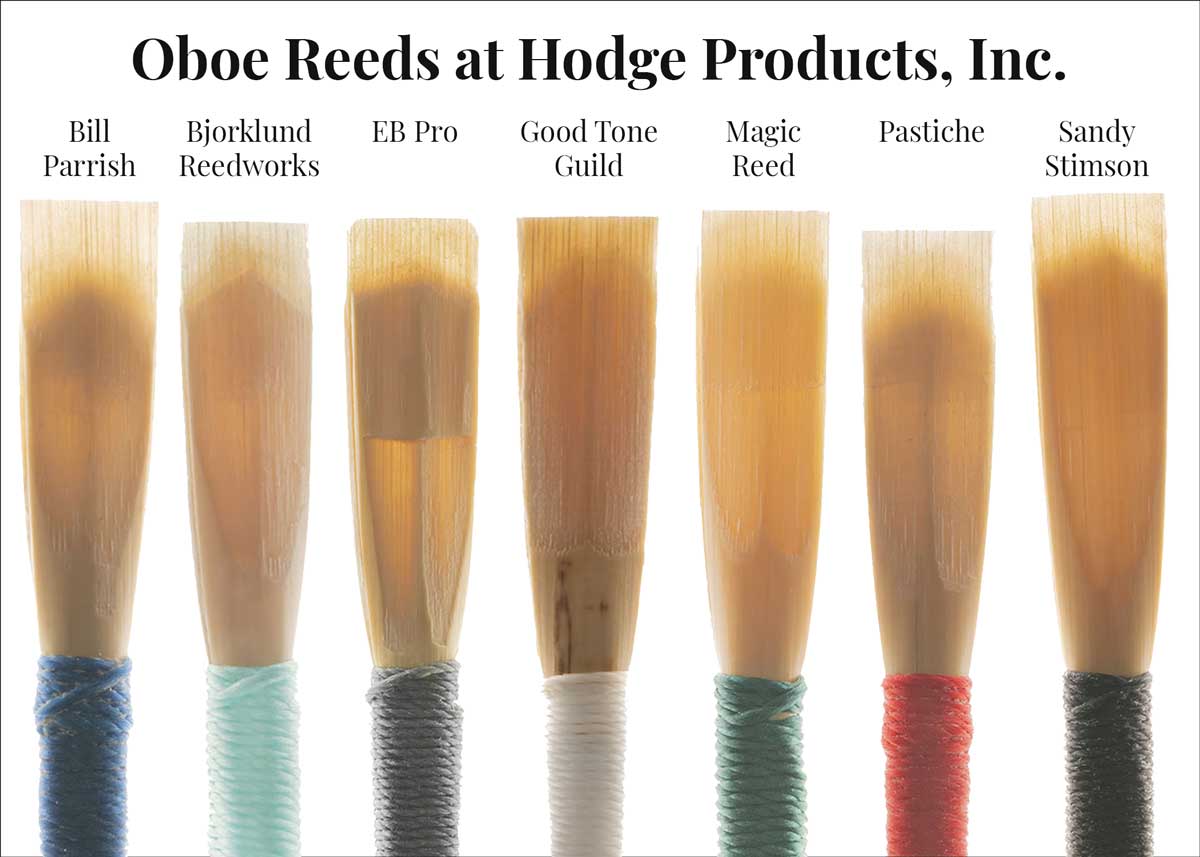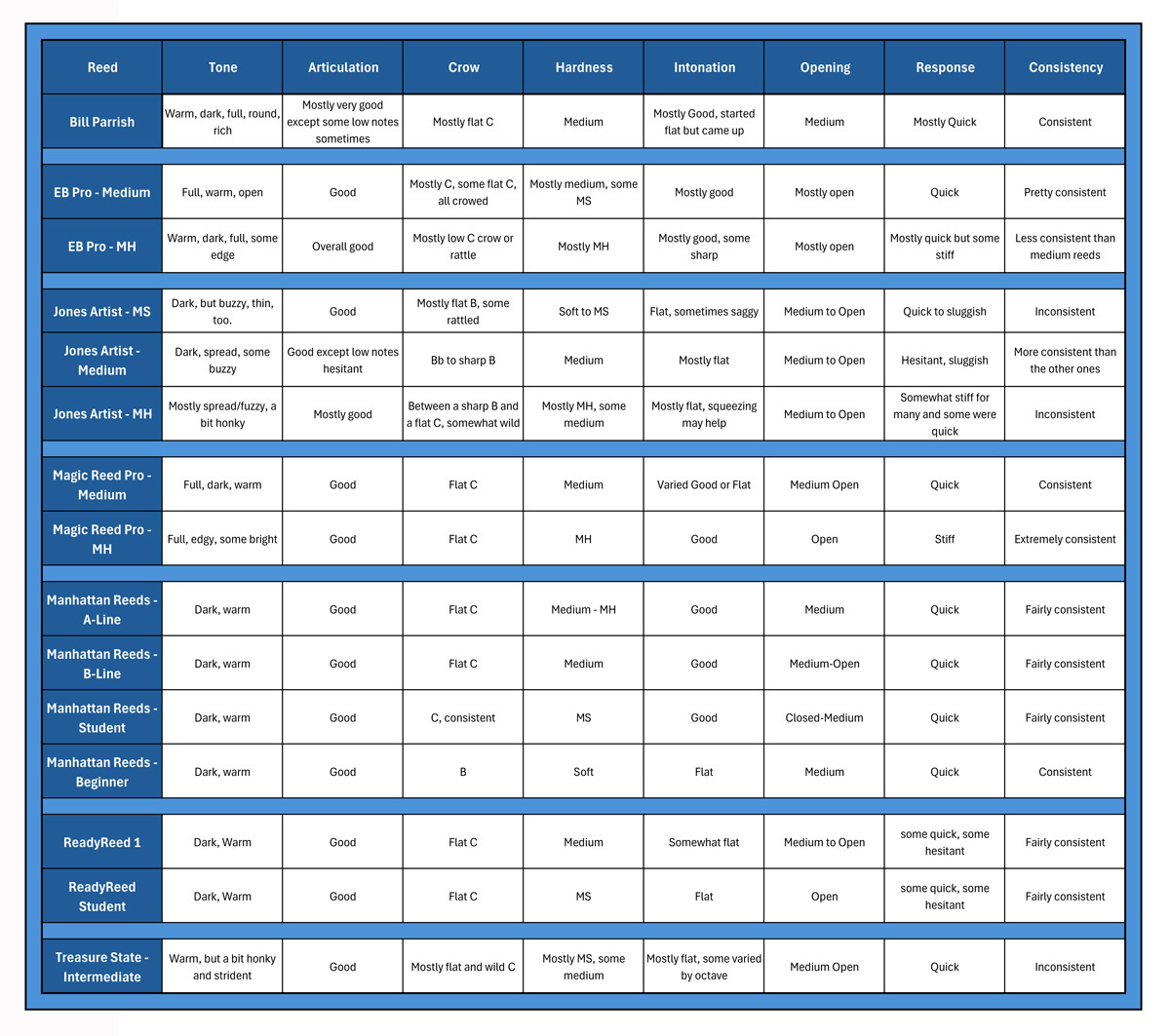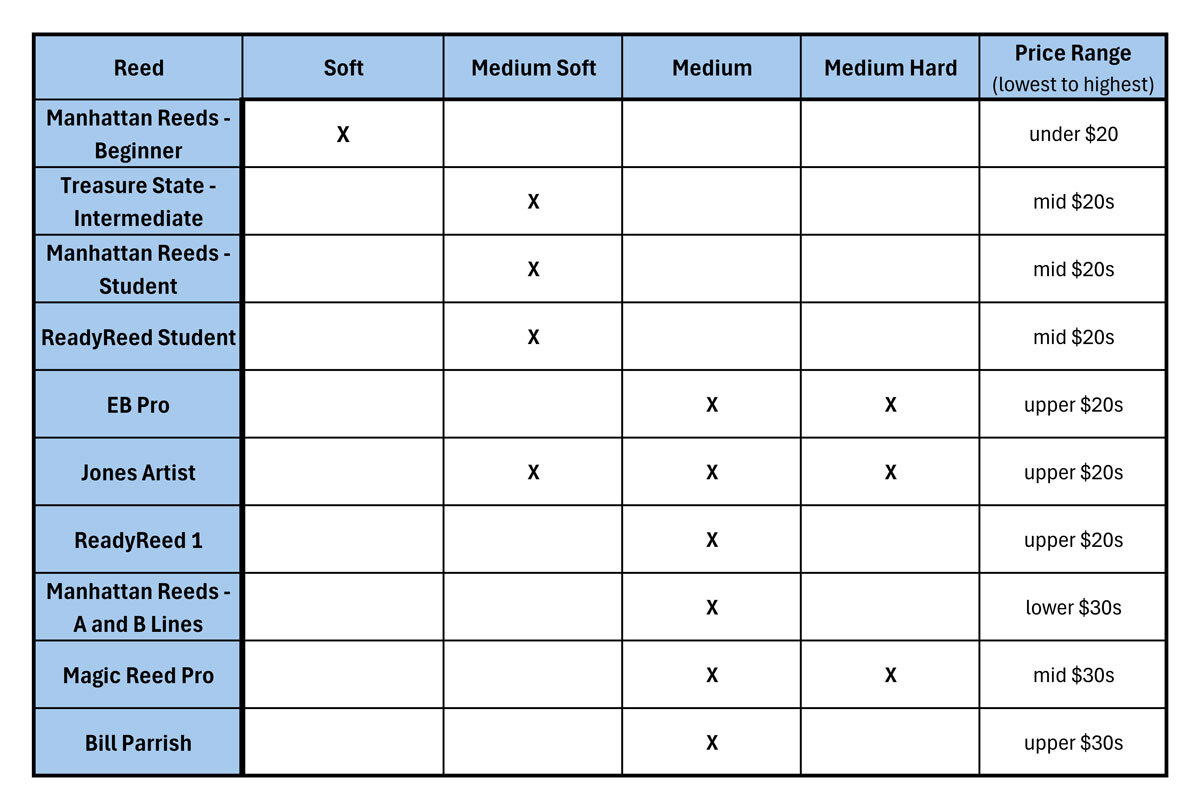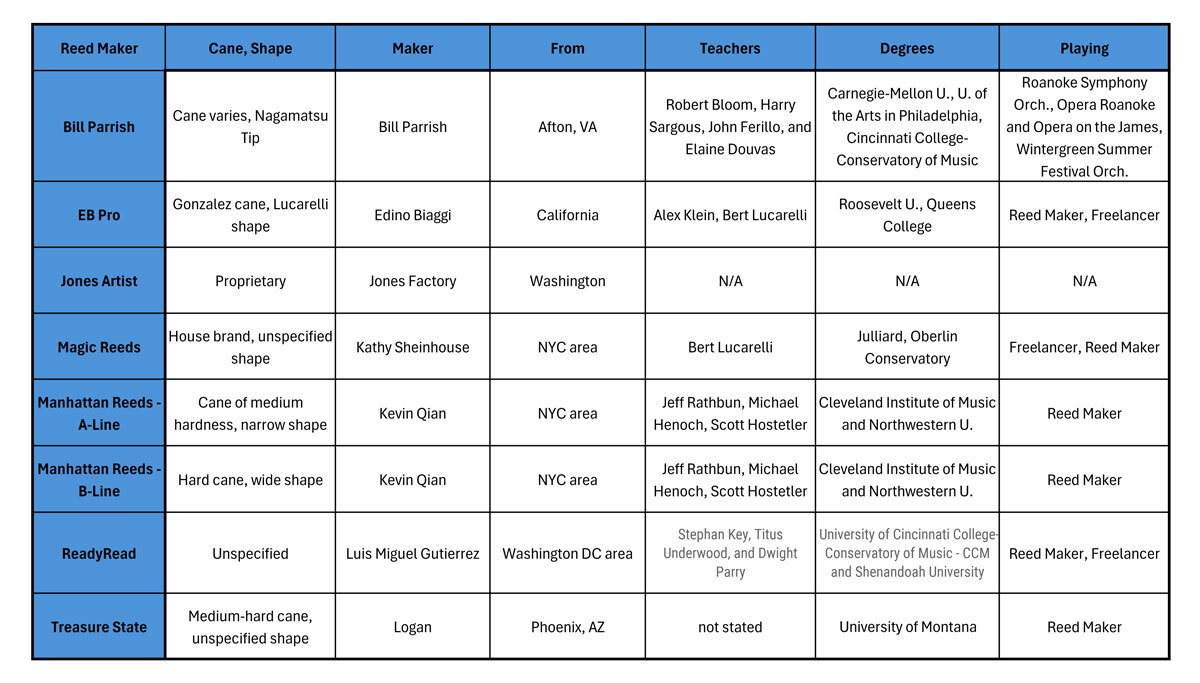Student to Professional Oboe Reeds: "Which oboe reed should I buy?"
Posted by Ann Hodge on Jul 16th 2018
UPDATE: This article is in the process of being updated. We no longer carry the Bjorklund, Good Tone Guild, Pastiche, or Sandy Stimson reeds. Other reed makers have been added to our offerings. We are working on updating the charts and pictures to reflect these changes. We hope to have an updated article by Dec. 13, 2024. You may still find our reed characteristics and tone color terms helpful as well as the descriptions and comparisons of the reeds we still have in stock. Check back in a week for a newly updated reed comparison blog article!
I have tried eight of every oboe reed that we sell at Hodge Products in order to give you a good overview of the qualities of each of the types of reeds. Before we start, let me say that every oboe player is different. Their physiology is different. Their instruments are different. Their ideal sound is different. So each player’s ideal setup combination is unique. My physiology includes thin lips which affects how well I can cover a reed thereby affecting the vibrations of the reed. Because of my thin lips, I need a reed that has more of the warm, dark tone built into the reed. A person with thicker lips can play a reed that is brighter and more strident in tone and naturally cover the sound more with the lips (using your lips to dampen or reduce the prominence of the higher overtones) so the overall result is warmer and darker. I play a Lorée FE series oboe with a bell that has been reamed out to match a D series bell which has given me a more stable upper register than I had before.
Each reed is made by a different oboe player with their own different physiologies, instruments, and tone goals. What should be similar is that the reed needs to vibrate evenly. This is the main characteristic that makes a reed worth buying at all. After that, the other qualities are going to be of interest for the individual players and their setups. I will try to summarize the descriptions of each reed to fit various types of players as well as present a chart organizing the reeds into types. But first, what do the words mean that I will be using to describe the tone of the reeds?
Definitions
Reed Characteristics
- Articulation - How easily notes can be tongued in quick succession.
- Consistency - How consistent all the reeds of a particular maker are compared to each other.
- Crow - The sound the comes out when the reed is blown while the lips are all the way down near the string of the reed. Ideal is a C5 with an octave below note with it. A rattle refers to many other notes with it. The crow gives an indication about the stability and intonation of the reed.
- Hardness - How hard the reed is to blow and get it to vibrate.
- Intonation - This is based on an A being at 440 Hz and refers to how all the notes sit relative to that.
- Opening - How open the tip of the reed is while playing. This can be adjusted by the lip pressure but a more open reed will take significantly more lip pressure than a more closed reed.
- Response - How quickly the reed begins to vibrate when it is blown at a normal rate.
- Tone Color - a full spectrum of harmonics available in the tone which the player can manipulate as desired.
Tone Color Terms
- Bright Tone - The higher harmonics are more prominent. Though this can sometimes sound harsh depending on the different harmonics present, it often penetrates into a concert hall better.
- Buzzy Tone - A distinct buzz is heard in the sound.
- Dark Tone - The opposite of bright, this refers to a sound containing more prominent low harmonics and less high. Depending on what other qualities are in the tone, dark sounds can sometimes get lost in a large hall although it is usually considered highly desirable by oboists.
- Edgy Tone - Select higher overtones are more prominent and lower ones are less.
- Full Tone - Connected to warm tone but perhaps referring to a fuller amount of the harmonic spectrum.
- Honky Tone - The tone is loud and tends to come out in spurts without much of control.
- Round Tone - This term is used when describing a tone produced from a reed with a large opening. It is often missing some harmonics making it sound less full and more hollow.
- Spread Tone - The sound is not focused and clear. Fuzzy is sometimes used to describe this as well.
- Strident Tone - This term applies to a brighter, edgy tone in which there is a clear sense of strength that will cut through all other sounds. It is usually not considered pleasant.
- Warm Tone - Technically, it’s containing more prominent low and midrange harmonics and slightly softened mid and upper harmonics leaving a less sharp attack on the notes. A warm tone is pleasant in all ways.
This chart separates the tone descriptions into what is considered desirable and undesirable. Understand that each of these paired tone descriptions is a spectrum, and good reeds or even the ideal reed is a balance of each spectrum. The reed you prefer will be based on which sound concepts or needs are most important at any given time in your playing life.
| Desirable | Undesirable |
| Dark | Bright |
| Focused | Buzzy |
| Full | Edgy |
| Open | Honky |
| Round | Spread |
| Warm | Strident |

Reed Descriptions
Bill Parrish

Bill Parrish’s reeds are the best reeds I’ve ever tried. I actually tried thirteen reeds in one sitting instead of eight and every one of them was really nice. They typically have a warm, full sound, are well balanced, and dark. I would even add that some of the reeds had an extra richness that was amazing. Bill’s reeds are of a medium strength and usually have a medium opening with good response. They typically started off slightly low in pitch but came up to pitch as they were played. My only concern is that for someone with thicker lips, these reeds may be too covered sounding and the rich, full sound may be lost. These reeds have it all for the person with thin lips.
EB Pro

Overall EB Pro reeds are very vibrant and open. They have a warm, dark, full sound. They are flexible with a good response.
The medium reeds are quite responsive with a medium to medium soft feel. They all have full openings which require a bit more lip control but also allow them to be flexible
The MH reeds are a little stiffer but still have the full, dark, warm sound. Some of these also have a bit more edge to the sound which can help with projection. They are less consistent reed to reed than the medium.
Légère

Légère has made an amazing reed out of a synthetic material! They have a dark, warm tone. The quick response is extremely consistent. I can play a low C at pianissimo easily on the MS reeds. And I don’t even need to soak it! They are extremely well balanced and require very little lip manipulation. There are only two down sides that I have experienced in using the MS. The upper register tends to be flat if the reeds are played in the normal American fashion. I have found that if I just roll in a little as I go into the upper register, everything sits perfectly in tune. It was not that hard to adjust to this. The other negative is that there is not a lot of tone color variation in these reeds. I miss the color choice but have found that the amazing stability in every other way makes up for that lack, especially as I am not in good enough playing shape to have the endurance to work with less stable but more colorful reeds. The medium reeds are equally stable with a beautiful tone. They are more resistant than the MS. The MH reeds are more resistant still and require more air than most Americans like to give, but if you like a stiff reed, the MH will be a great reed for you.
The price point of this reed will undoubtedly startle many a player but a few things need to be considered here. As a synthetic reed, it will last much longer than the traditional cane reed. With regular playing, it can last a month without change. Eventually it will be more closed and a little less full sounding but will still play consistently for months more. This may not be acceptable for a professional but a student will probably not be as aware of the subtle changes and can happily play on this reed for months. It only takes the purchase of 6-7 reeds to equal the cost of this and most players go through more than that in a month or two depending on their level of playing and amount of playing.
Magic Reeds

Magic Reeds are extremely consistent from reed to reed. They are a stiff medium hard, leaving plenty of room to adjust yet they already have a full, strong tone for those who like a stiffer reed.
Reed Comparison Chart
Following is a chart showing a comparison of all the characteristics between the reeds being discussed.

Hardness & Price Chart
This chart may be helpful in seeing what strengths of reeds are available and their price points. For a beginner, the Manhattan Beginner reed is recommended. For all other young players or older who like a soft reed, the Manhattan Student, ReadyReed Student, and Treasure State reeds are good choices. For more advanced student players and professionals who like softer reeds, any of the medium reeds are a good choice. Make sure to have read the descriptions of them to make the right choice for you. If you like a lot of resistance, the most consistent MH reed is the Magic Reed.

About the Reed Makers
Other factors that affect how a reed maker makes their reeds are where the maker lives, and the teachers that have influenced them. This chart gives a little more information about the makers for those who understand the meaning of these influences.

Conclusion
I hope all of this information helps you understand the many different aspects of oboe reeds and how to determine which reeds might be best for you. Keep in mind that you will evolve in your playing and that you may prefer or need a totally different style of reed within a year or even a few months...and there’s nothing wrong with that! Our job at Hodge Products is to understand your current needs and help you to find the reeds on which you sound best right now. We are always happy to help!

